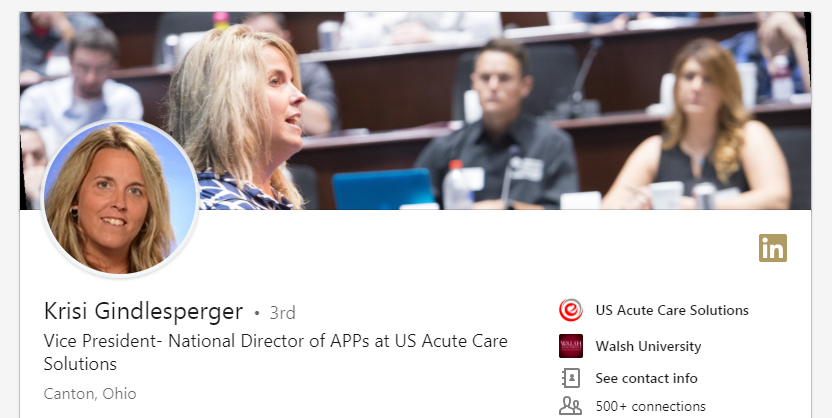6 Tips to Leverage LinkedIn
PA Shares Her Can’t-Miss Tips
March 26, 2019
By Kate Maloney

Krisi Gindlesperger, MPAS, PA-C, Vice President, National Director of Advanced Practice Providers at US Acute Care Solutions, is a PA, an administrator, and a leadership development consultant. She is as also an avid user of LinkedIn. She finds the social media network enormously helpful for her own professional networking and development and finds it invaluable when it comes to recruitment. At AAPA’s Leadership and Advocacy Summit, Gindlesperger led a discussion on LinkedIn’s importance in any PA’s career. “LinkedIn is the tool to build your professional relationships, both early on and throughout your career,” she said. Here are six of her top tips.
[AAPA 2019 CME: Missing Out If You Are Not LinkedIn.]
Keep your LinkedIn account professional.
“Don’t post what you had for lunch on LinkedIn!” Gindlesperger laughed. LinkedIn is a professional networking platform, and it should stay that way. “LinkedIn should showcase your skills, expertise, education, and experience,” Gindlesperger said. In her administrative role, Gindlesperger knows just how much employers use LinkedIn to scope out a job candidate. “The first thing I do when reviewing job applicants: I pull up their LinkedIn profile and review it.” Consider your LinkedIn account an extension of your resume, and count on employers reviewing it during the application process.
Showcase your personal brand.
While you should avoid being overly personal on LinkedIn, Gindlesperger advises using LinkedIn to detail your career path and highlight your interests. “Use LinkedIn to communicate your personal brand,” she said. She defines a personal brand as what you believe in, how you practice medicine, your skills, and the expertise you bring to the table. “People should look at your profile and know what to expect,” she shared. “Let everyone see your path. It paints your picture, and even if you have a non-medical background, it’s still you!” Think about presenting your personality on LinkedIn, not just an electronic resume.
[AAPA 2019 CME: Building Your Brand and Professional Healthcare Community on LinkedIn.]
Perfect your summary statement.
According to Gindlesperger, the most important aspect of a LinkedIn profile is the summary statement. Spend some time perfecting yours. Your summary statement should explain who you are as a professional and what you’re interested in. “This is the number one most important thing you can do for your LinkedIn profile,” she said. “It exhibits your experience and expertise, communicates what you’re passionate about, and gives recruiters and employers an idea of your personal brand.”
Be judicious with your connections.
Remember, LinkedIn is a professional networking tool. You want to connect with people who can help you professionally – whether that’s finding your next job or simply sharing interesting articles that you otherwise may not have read. Gindlesperger confessed that she is judicious with her own connections. “I won’t connect with people who don’t have anything to do with my profession,” she said. “You’ll end up with totally unrelated articles cluttering your feed, and connecting with a realtor on LinkedIn won’t do anything to advance your PA career.” Gindlesperger admits that it can be awkward to decline a friend’s connection request, but she finds a direct explanation best: write them back a message and explain that you’re looking to build your professional, healthcare-related network.
[PA Krisi Gindlesperger’s Path to Leadership.]
Use LinkedIn to do your own job-related research.
It’s easy to think of LinkedIn passively. You build your profile and recruiters or employers will look at it when you apply for jobs. But it’s much more helpful than that – what if you’re really interested in a company, and you want to get them your name? Gindlesperger said: “Connect with people who currently work there! When you’re looking to connect for a specific reason, use inbox messaging and make sure you mention why you’re reaching out.” You can use LinkedIn when you aren’t sure to whom you should address cover letters, or when you’re filling out an automated job application and want to add a face and a name.
Update your profile from time to time, and be specific.
“There will be times in your career when you think you don’t need to keep up with LinkedIn,” Gindlesperger warned. “Things are going smoothly, you love where you work. But life changes all the time, and it’s much easier to keep your LinkedIn profile updated rather than having to go back and recreate the last however many years of your life.” Get used to keeping LinkedIn up to date when you aren’t looking for a job, so that when you are starting to search, it’s all set to go. “’PA in emergency department’ isn’t really going to tell anyone much,” she said. “List your actual responsibilities.”
Kate Maloney is AAPA’s senior manager of corporate communications. She can be reached at [email protected].
Additional Resources
Job Search
AAPA’s LinkedIn
PA Krisi Gindlesperger’s Path to Leadership
AAPA 2019 CME: Missing Out If You Are Not LinkedIn
AAPA 2019 CME: Building Your Brand and Professional Healthcare Community on LinkedIn
Thank you for reading AAPA’s News Central
You have 2 articles left this month. Create a free account to read more stories, or become a member for more access to exclusive benefits! Already have an account? Log in.



